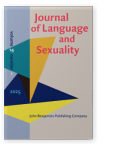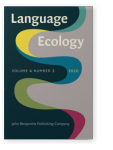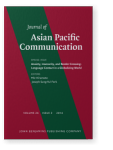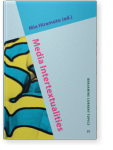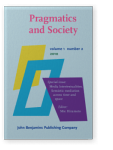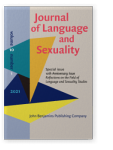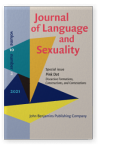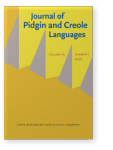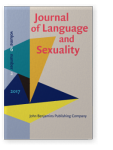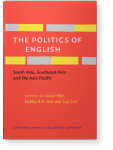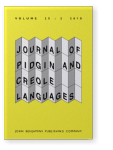Mie Hiramoto
List of John Benjamins publications for which Mie Hiramoto plays a role.
Journals
ISSN 2950-578X | E-ISSN 2950-5798
ISSN 2211-3770 | E-ISSN 2211-3789
ISSN 2452-1949 | E-ISSN 2452-2147
Who’s really normal? Language and sexuality in public space
Edited by Mie Hiramoto
Special issue of Journal of Language and Sexuality 4:2 (2015) v, 109 pp.
Subjects Discourse studies | Sociolinguistics and Dialectology
Anxiety, Insecurity, and Border Crossing: Language Contact in a Globalizing World
Edited by Mie Hiramoto and Joseph Sung-Yul Park
Special issue of Journal of Asian Pacific Communication 24:2 (2014) vi, 184 pp.
Subjects Afro-Asiatic languages | Altaic languages | Communication Studies
Subjects Discourse studies | Pragmatics
Media Intertextualities: Semiotic mediation across time and space
Edited by Mie Hiramoto
Special issue of Pragmatics and Society 1:2 (2010) iv, 141
Subjects Discourse studies | Pragmatics | Sociolinguistics and Dialectology
2021 Reflections on the Journal of Language and Sexuality and the view from Japan 10th Anniversary Issue: Reflections on the Field of Language and Sexuality Studies, Leap, William L. and Heiko Motschenbacher (eds.), pp. 37–47 | Article
This paper discusses contributions of the Journal of Language and Sexuality made in the past decade in publication in relation to a development of the field currently recognized as language, gender and sexuality. I detail the development by using studies on joseigo ‘Japanese women’s language’… read more
2021 For family, for friends, for (true) love: Negotiating discourses of love within the LGBTQ community in Singapore Pink Dot: Discursive Formations, Constructions, and Contestations, Bharat, Adi Saleem, Pavan Mano and Robert Phillips (eds.), pp. 105–128 | Article
We examine promotional materials produced by two organisations in Singapore, TrueLove.Is and Pink Dot, to investigate how these two groups employ discourses of love to support their opposing views regarding the reconcilability of Christianity and same-sex desire. TrueLove.Is is a Christian… read more
2020 Two Englishes diverged in the Philippines? A substratist account of Manila Chinese English Journal of Pidgin and Creole Languages 35:1, pp. 125–159 | Article
Although World Englishes (WE) scholarship is concerned with the study of English varieties in different social contexts, there is a tendency to treat postcolonial ones as homogenous regional phenomena (e.g., Philippine English). Few researchers have discussed variation and social differentiation… read more
2017 Building a body of followers: Neoliberalism and online discourse of fitness and masculinity Journal of Language and Sexuality 6:2, pp. 262–291 | Article
In 2014, a British journalist coined the term spornosexual to account for the emergence of a body-obsessed version of metrosexuality. While metrosexuals practice beautification rituals, spornosexuals are men obsessed with developing muscular bodies and self-objectifyingly flaunting them online.… read more
2015 Who’s really normal? Language and sexuality in public space Who’s really normal? Language and sexuality in public space, Hiramoto, Mie (ed.), pp. 183–192 | Article
2015 Heteronormative love makes a house a home: Multimodal analysis of luxury housing ads in Singapore Who’s really normal? Language and sexuality in public space, Hiramoto, Mie (ed.), pp. 223–253 | Article
This study investigates how luxury apartment housing advertisements in Singapore function as meaning-generating institutions through visual and textual discourse. Advertisements are designed to ascribe a set of attitudes, values, and preoccupations to a group and to imbue their audiences with the… read more
2014 “Island girl from the island”: Tattooed symbols and personal identities in contemporary Hawai‘i Anxiety, Insecurity, and Border Crossing: Language Contact in a Globalizing World, Hiramoto, Mie and Joseph Sung-Yul Park (eds.), pp. 173–195 | Article
This study investigates the construction of hybrid identity and cultural values as demonstrated by local Hawai‘i residents in the multiethnic urban community of Honolulu. Due to its unique historical background, Honolulu has become host to a variety of Pacific and East Asian ethnic and cultural… read more
2014 Anxiety, insecurity, and border crossing: Language contact in a globalizing world Anxiety, Insecurity, and Border Crossing: Language Contact in a Globalizing World, Hiramoto, Mie and Joseph Sung-Yul Park (eds.), pp. 141–151 | Article
The modern conception of the self is grounded in stability and identity. Under this perspective, anxiety and insecurity of the border are only characteristic of peripheral communities. However, anxiety and insecurity are much more fundamental to linguistic life; heterogeneity of linguistic practice… read more
2013 12. English vs. English conversation: Language teaching in modern Japan The Politics of English: South Asia, Southeast Asia and the Asia Pacific, Wee, Lionel, Robbie B.H. Goh and Lisa Lim (eds.), pp. 227–248 | Article
From the mid-1800s, at the end of the Tokugawa feudal period and the beginning of the Meiji era, English has been a singularly important foreign language in Japan which has, since that time, risen to international prominence, mirroring the rise of the English speaking world powers in the west.… read more
2012 Anime and intertextualities: Hegemonic identities in Cowboy Bebop Media Intertextualities, Hiramoto, Mie (ed.), pp. 57–79 | Article
Cowboy Bebop, a popular anime series set in the year 2071 onboard the spaceship Bebop, chronicles the bohemian adventures of a group of bounty hunters. This paper presents how the imaginary characters and their voices are conventionalized to fit hegemonic norms. The social semiotic of desire… read more
2012 Media intertextualities: Semiotic mediation across time and space Media Intertextualities, Hiramoto, Mie (ed.), pp. 1–10 | Article
2011 Is dat dog you’re eating? Mock Filipino, Hawai‘i Creole, and local elitism Pragmatics 21:3, pp. 341–371 | Article
This paper explores both racial and socioeconomic classification through language use as a means of membership categorization among locals in Hawai‘i. Analysis of the data focuses on some of the most obvious representations of language ideology, namely, ethnic jokes and local vernacular.… read more
2011 Consuming the consumers: Semiotics of Hawai‘i Creole in advertisements Journal of Pidgin and Creole Languages 26:2, pp. 247–275 | Article
Previous sociolinguistic research concerning the use of Hawai‘i Creole (HC) in public discourse has posited a link between a negative public image and subsequent discouragement of its use by government and media (e.g. Romaine 1999; Sato 1989, 1991, 1994), except in some limited venues. This paper… read more
2010 Dialect contact and change of the northern Japanese plantation immigrants in Hawai‘i Journal of Pidgin and Creole Languages 25:2, pp. 229–262 | Article
This paper investigates changes in the dialect of a group of northern Japanese immigrants from the Tôhoku dialect speaking areas who migrated to Hawai‘i. The speakers moved to Hawai‘i as sugar plantation workers between 1899 and 1923 and the data were recorded between 1972 and 1975. Being… read more
2010 Anime and intertextualities: Hegemonic identities in Cowboy Bebop Media Intertextualities: Semiotic mediation across time and space, Hiramoto, Mie (ed.), pp. 234–256 | Article
Cowboy Bebop, a popular anime series set in the year 2071 onboard the spaceship Bebop, chronicles the bohemian adventures of a group of bounty hunters. This paper presents how the imaginary characters and their voices are conventionalized to fit hegemonic norms. The social semiotic of desire… read more
2010 Media intertextualities: Semiotic mediation across time and space Media Intertextualities: Semiotic mediation across time and space, Hiramoto, Mie (ed.), pp. 179–188 | Article
